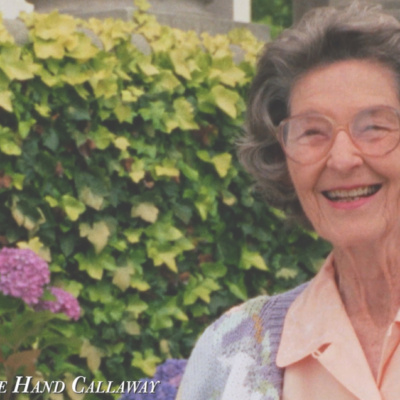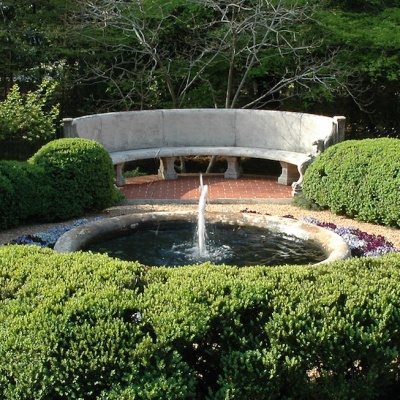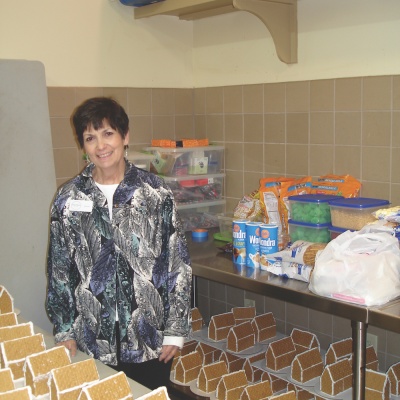The Alice Filter
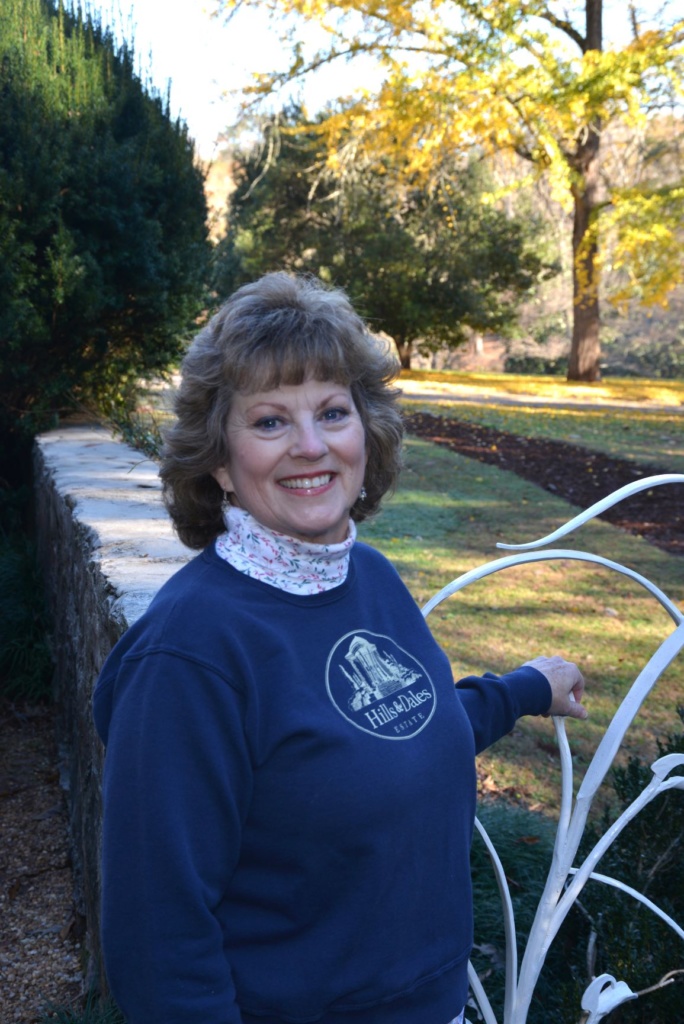
In May, Jo Phillips who serves as Horticulture Manager at the estate completed 25 years of service. As our longest serving staff member and the only employee who was hired by Alice Hand Callaway, she has a unique perspective on work at the estate. This momentous milestone presents a good opportunity to sit down and talk to Jo.
How did you meet Mrs. Callaway and come to work at the estate?
The very first time I met her, I came to tour the garden when I was a young intern at Callaway Gardens. That was my first glimpse of Hills and Dales. In the 1980s I was working at the Farmer’s Supply Store and Mrs. Callaway was one of our customers. My co-worker, Joe Harman, usually waited on her but sometimes I would assist her instead. She was very low key and did not like attention called to herself or a fuss made when she came in. She would pull up in her station wagon to buy seeds, fertilizer, and other garden supplies. I remember helping her get cottonseed meal and once giving her a Clematis that really needed a home.
Several years later I had a part-time job in Meriwether County and needed full-time work. I didn’t want to commute to LaGrange again unless it was the perfect job. Joe Harman called and told me Mrs. Callaway wanted to talk with me and it was probably about a job. I said, “Oh my Gosh.” I called her and she said she had an opening on her garden staff and remembered me from the supply store and that it seemed like I really loved plants. I had no idea that I had made an impression. I drove in the front gate and she was waiting for me. I was really nervous. She took me on a garden tour, and afterward, we sat at the pool terrace and talked – she wanted to know about my background, etc. A short while later she called and offered me the job. That was 1994 and I thought it was the perfect job because it was horticultural I wouldn’t have to work on Sundays.
Can you tell us about a few memories of the garden with Mrs. Callaway?
Well, I have already relayed the one about killing the grasshoppers…but the first time I saw that I was pretty wide-eyed because they are a BIG bug and she had no trepidation whatsoever about killing them. Grasshoppers would come in the mornings and sit on top of the boxwood. Mrs. Callaway would walk the garden, picking them off left and right and throwing them down on the ground, stomping them.
I remember once she had ordered a pamphlet from the Brooklyn Botanical Garden, on invasive exotic plants because that was a real horticultural hot button. She knew what a ‘horticulturally political’ issue invasive plants were becoming, so she came down to the greenhouse with the pamphlet, plopped it on my desk and said, “Jo you may want to read this because everything I like is in it!” She was not happy about it at all.
My fondest memory is when I came to work here and my children were eight & four. She let me bring them to work with me on Saturdays when I had water duty. She loved children. Mine were well-behaved and they didn’t run in and out of the boxwood so she was fine with them coming with me. Probably the second or third time they came, Chris ran up to me and said: “Momma, you work at the Garden of Eden”! That statement was precious to me because it was so perceptive of the imagery in the garden, and I thought that was a very astute observation considering his age and the theme of the garden. That has always stuck with me because it is very “Eden-like” and I really enjoy the fact that so many people who visit here appreciate it as such a peaceful place and they can enjoy it for what it was intended – a space of peace and quiet.
What was one of your funniest memories with Mrs. Callaway?
We reported to work at 8 a.m. and she was always there when we arrived. On Monday mornings she would ask, “So what did you all do over the weekend?” I said, “OHHH, we went and got a load of chicken manure for our vegetable garden.” She went on about how fine chicken manure was and how she wished she could have some. I told my husband, Rob, and so the next day, he brought her two, five-gallon buckets of chicken manure, and just left it outside the greenhouse and drove off. She said, “I didn’t even get to thank him,” so she wrote him a note, thanking him for the fine fertilizer and she knew her tomatoes were going to love it. Rob said, “I’ll bet I am the only person in the world who received a thank you note for chicken crap!” He was so flattered.
I heard that Mrs. Callaway was resourceful?
She was all about being proper but she was also very down to earth, practical, pragmatic person. She kept bread bag ties and we used them to tie up plants. She saved Coca-Cola caps from the glass bottles and placed them over the drain hole of clay pots so the little fluted edges would let the water flow under. She saved mop and broom handles and garden staff would turn one end into a point to use for stakes. She saved burlap from the bags of cottonseed meal.
Where did she buy her plants?
She would mail order from specialty nurseries, things that she had read about or researched and wanted to try here. They would arrive as small plants. She did not mind starting young. In fact, she was a little critical of what she called “instant topiary,” people who started with a full, ready-made landscape. She wanted to be part of the process, and she loved to start things from her own cuttings or from her own seed if she could. You know she was in her 80s so if she ordered something particularly unusual that happened to bloom for the first time, she would make a statement like, “Well I can die happy now that I saw such and such bloom.” I would say, “Don’t say that!” and she would say, “Well I can.” She was not above buying from large retailers. She bought a couple of plants from Kroger – one a miniature cymbidium and she told me that it was just so pretty she could not leave it there to die, so she bought it. We still have it and call it “The Kroger Orchid.”
What is an example of some things that are still the same and some that are different?
We don’t use cottonseed meal now and we don’t use homemade potting soil. We use a commercial mix that is so much lighter. We do keep the callas a little differently, but we still grow them in compost like she did and we still dig them up and let them go dormant the same time that she did. We still have the staghorn ferns over the doors as she did as a joke of hanging true stag heads on the walls and above the door. She told me that every garden needs a little whimsy. We do try to keep her plants alive. We still have a lot of them and they are arranged as she had them. You know that stephanotis in the first section of the greenhouse and it’s still growing in the same place it was when I came to work here.
What impressed you most about Mrs. Callaway?
I remember Mrs. Callaway’s kindness. She was gracious and generous, such a giving person. She insisted on giving my children Christmas presents every year. But she brought a catalog down and showed me pictures of what she had picked out for my children and I said, “Oh, Mrs. Callaway you don’t have to give them anything,” but she said, “I know I don’t have to but I want to.” I remember the first year I was working here, the UPS truck came at least once a week year-round. The UPS man’s name was Dennis and she gave him a Christmas present. She was just so sweet.
From the experience you had with her, did you glean what the garden meant to her?
My mother-in-law died tragically in 1997 and she said to me, “My advice to you is to come back to work and just work. It will help you get through it. It will help you get your mind off of it. That is what will help you get over this. To get back into the garden.” Alice said, “The garden has saved my life more than one time. It was very personal to her. Her whole psychology of life was enriched by her gardening experience. She was also a spiritual person and talked about the Lord a lot.
How does having known Mrs. Callaway and now being the head of the garden staff affect you taking care of the garden?
Well, I know that influences my decisions – I try to put everything through what I call “the Alice filter,” you know, what would she do in this situation or what would she want to be done. I think about the flowers and colors she liked when we pick out annuals for the garden. She loved pink and white and she loved salmon-pink was probably her favorite hue PERIOD. She did not HATE red but she used red sparingly. She liked yellow and she sometimes used a yellow and white theme in the Ray Garden. She really became a fan of white flowering plants and plants with silver and variegated foliage.
What thoughts do you have on the future of the garden?
The way that I look it, God has always taken care of this garden, and I feel He has always sent the right people at the right time. You look at the staff through the years and we have always had the right people. I probably worry more about the weather, climate change and some of the ramifications from those things beyond our control.
Five additional questions from our interview with Jo Phillips.
Can you tell the Yew Story?
(Jo laughing) That was classic. There is an L shaped yew hedge planted near the bird gate. Alice said that she was told she would not be able to grow yew successfully in Georgia. I don’t know if she had already had them planted or if she told someone she wanted to plant them, but she took that as a challenge. The yews were nice, large specimens when I came here. They were gorgeous. There was one big gap, which you can hardly see now, but there was a very pronounced gap then and they were mature plants. So I asked her, “I see the gap there, did you lose one?” and she said, “Yes I did and I decided not replace it because I had such success when I was told that I would not, so I left that hole there to keep me humble!”
Do you know if she had any role models when it came to gardening or if there were any gardeners who she looked up to?
I know she liked Henry Mitchell, he was a writer for the Washington Post and she read all of his stuff. She had all of Elizabeth Lawrence’s books but she didn’t talk extensively about them. Of course, she admired the Brits but she didn’t just bomb over them–Gertrude Jekyll and Rosemary Verey–she met the latter. She had a good relationship with Dr. Marc Cathey from the National Arboretum and he came here to visit her. She had his soil recipe but she told me she liked her recipe better.
What’s your favorite thing about your job today?
I appreciate the fact that our horticultural staff loves the garden so much and they care about what they do. One of my favorite things is seeing the garden come out of dormancy, seeing it come alive in the spring. One thing I remember Mrs. Callaway saying is that she would give this garden to anyone who wanted it in January and February but she would want it back in the spring! And that is so true.
What was it like for the garden staff when Mrs. Callaway passed away?
It was a Friday morning and there was a grandparent’s luncheon at LaGrange Academy. Some of the grandchildren were going there and they had wanted her to come. She told me that morning, “I’ve got to go inside early and change my clothes, and get ready to go to the luncheon.” She came out–she had her red wool coat on, grey slacks and I told her she looked pretty. I saw her get into the station wagon–she was wearing red for Valentine’s day. I saw her come home and go up the back steps inside. That was the last time I saw her. She had told me more than once that she wanted to be working one day and die the next and that’s what happened. It was that Sunday when she passed and I got a call from her son-in-law, Mr. Hudson. We reported to work the next morning. We did our best to cope but we were all very sad.
What do you think Mrs. Callaway would think of Hills & Dales today? Do you think she would be happy that the public can visit?
Oh yes, that was her wish and I think she would be very pleased with her grandchildren and great-grandchildren and the way that they have stewarded the property. She would be so pleased that they love it like they do. You know she was already exploring options, she had the Garden Conservancy come here before she passed away. They came and toured and she corresponded back and forth with them a good bit, but I think she had already determined that they would have completely taken over the reins and I think she much preferred the way it is now–stewarded by the family.
As far as the care of the garden, I sometimes worry that Mrs. Callaway would not like us using gas shears rather than hand clipping the boxwood but it took a whole week to get that done by hand back then. We are open to the public now and don’t have that kind of time. We do clip the mottos as she did, using the stencils, but we did make some new stencils to use so that we would not ruin hers.
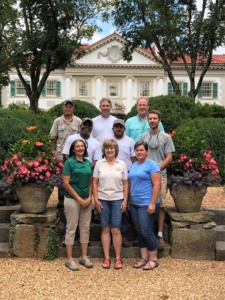
Jo Phillips leads a team of seven gardeners who tend Alice’s garden. They are (left to right, front row) Tina Eturralde, Jo Phillips, Charlotte Baker (second row) Willie Hall, Aaron Moon, Jeremy Oxford (back row) Jeremiah Roberts, Chris Smith, and David Brown. |
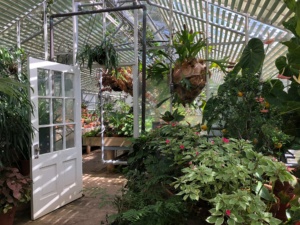
Staghorn ferns in the Callaway’s greenhouse. |
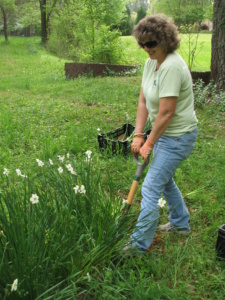
Rescuing heirloom daffodils from development. |
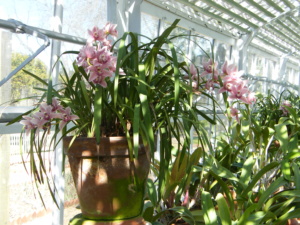
Mrs. Callaway’s “Kroger Orchid.” |

Jo teaching a group of 5th grade students about culinary herbs and their benefits. |
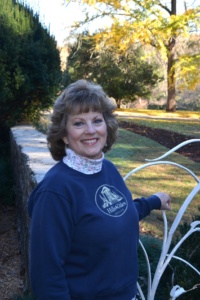
Jo standing next to the bird gate that was added to the garden by Alice Callaway. |
View this entire Portico Newsletter:
